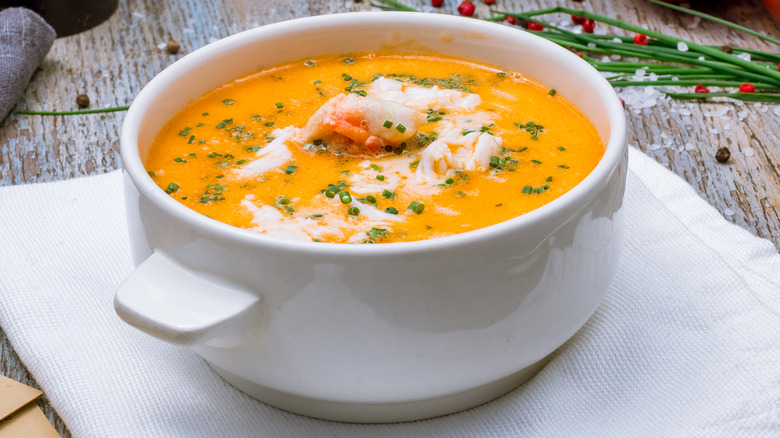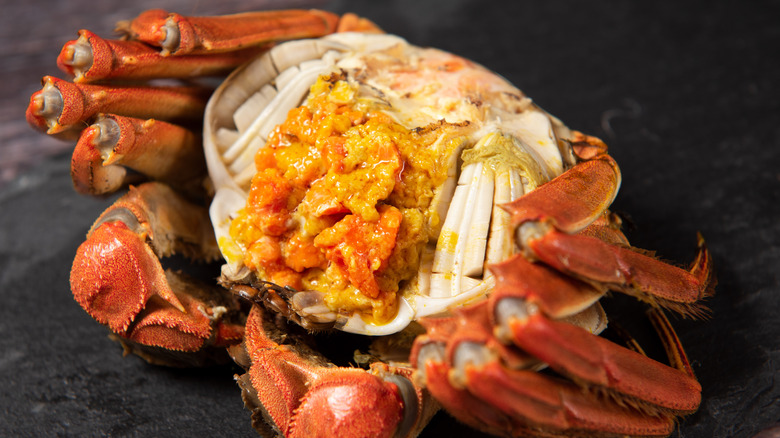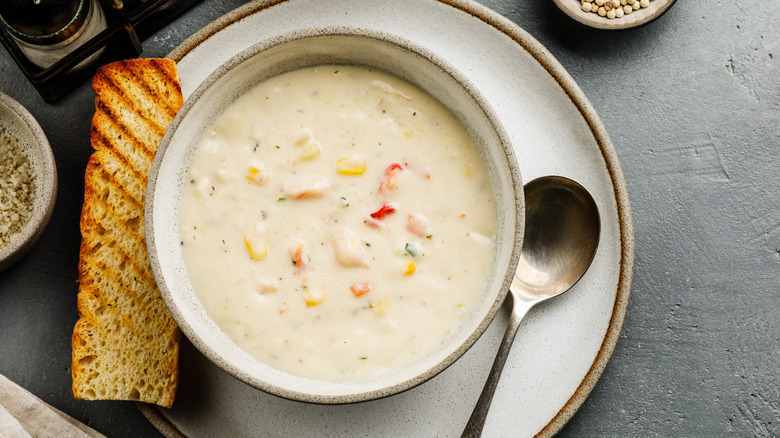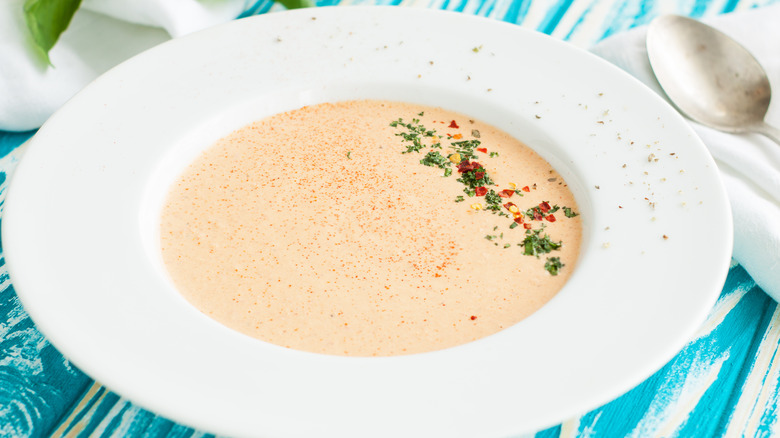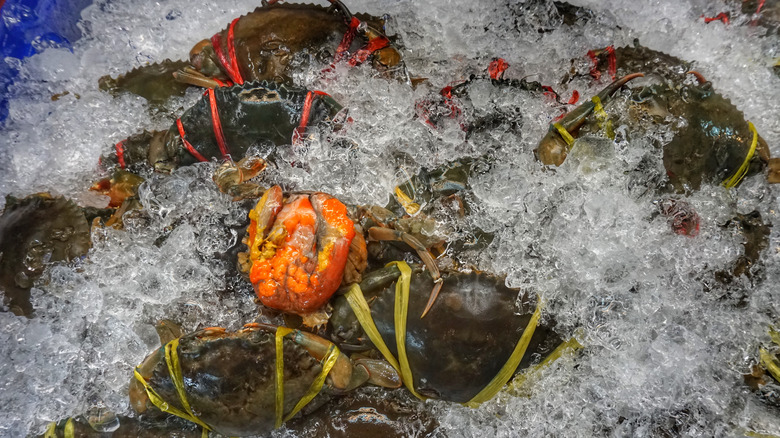She-Crab Soup Is The Fancy Crab Roe Take On Chowder
We may receive a commission on purchases made from links.
In the South Carolina Lowcountry, a rich diaspora of foodways converges on a long stretch of coastline. With influences from Gullah-Geechee, French, and Southern cuisines, the signature flavor of Lowcountry cooking is full of rice, spice, and savory seafood. Shrimp and grits, oyster roasts, and the quaintly-named Frogmore Stew are all unique features of the culinary tradition. But there's another classic dish hailing from the area that's worth your attention: the creamy, dreamy she-crab soup.
The first thing that strikes you when you see a bowl of this unique soup is its golden-orange hue, which is courtesy of the umami-rich crab roe stirred in. Tangy and tart, crab roe has a kind of culinary X-factor, elevating everything it touches, including a humble bowl of soup. Straddling the line between a crab chowder and a crab bisque, she-crab soup has all the silky texture you could want — sans the vegetable fillers. So what's the story behind this delicious dish with the interesting name?
The history of the Lowcountry classic
The origin of the she-crab soup can be traced all the way back to the Scottish settlers who arrived in the Carolinas during the 19th century. Included in their collection of old-world recipes was one for partan bree — a Scottish crab-based broth that translated well to the coastal Lowcountry, where the settlers thickened their soups with something not common to Scotland — rice, a staple crop in the area that became known as "Carolina Gold." Still, these early incarnations lacked that orange roe luster.
For the first bowl of true she-crab soup, we need to thank the 27th President of the United States, William Taft and William Deas, an African chef and the butler for the mayor of Charleston. In the early 1900s, Deas was preparing a massive feast for Taft and wished to make a twist on turtle soup, one of the president's favorite dishes. Making the most of South Carolina's rich access to crab, Deas created an elevated take on the humble crab soup by adding a generous dose of crab roe. Since these eggs came from the female crab, the soup was dubbed "she-crab soup" and became an instant classic.
The key ingredients to she-crab soup
Since the dish takes after turtle soup, it should come as no surprise that the two share a number of distinctive ingredients, like sherry, cream, and often clam juice and Worcestershire sauce. As for the crab meat used, it's best to reach for lump blue crab meat which, it should be noted, most often comes from male rather than female crabs. While female crabs tend to have a sweeter, more delicate flavor, they also tend to be much smaller and therefore have less meat to harvest.
A female crab's roe or eggs are not only the source of the soup's orange color, but is easily the hardest ingredient to come by, as it is both a seasonal and highly regulated product. The Charleston Sea Food company sells a pricey version of fresh crab roe, while other brands can offer year-round frozen versions. There are options for canned crab roe paste, an Asian condiment, but this ingredient is a significant departure from the crab roe often used in traditional she-crab soup and has other add-ins, like mashed crab meat. In a pinch, chefs sometimes substitute two grated hard-boiled egg yolks for the crab roe but you're not, strictly speaking, making she-crab soup at that point.
How to make your own she crab soup
If you have access to the elusive crab roe, she-crab soup is easy enough to make at home. Most recipes for she-crab soup begin with an aromatic sauté of onions and celery in a bit of butter. Next, you'll add a bit of all-purpose flour, creating a roux base that mimics the steps of making gumbo. You'll keep this roux light, or "blonde," and then begin to the rest of your aromatics, like spices, sherry, clam juice, and/or Worcestershire sauce.
Once things come up to a simmer, you'll add stock and then, the most important ingredient, crab roe. This will cook for a short period of time, 10 minutes max, as the intention is to heat it through, not thicken or reduce the soup at this point. Finally, the creamy bits, a blend of half-and-half, heavy cream, or milk can be added in, and you'll simmer until warmed up. The very last thing you'll add to your soup is your lump crab meat, as you want it to receive minimal handling/stirring so that the lumps aren't inadvertently broken apart. Still have some leftover roe? Be extravagant and top off your dish with an extra dollop.
Why you can only get she-crab soup in spring
If you're looking to savor some of the best she-crab soup in the U.S., it's best to head to the South, particularly in Charleston or Savannah, where the soup originated. Recipes for the dish seldom diverge from the original, as tradition is obsessively held to in the old-fashioned Southern establishments that dispense it.
In many states, including Texas, Louisiana, and New York, it's illegal to harvest "sponge crabs," which is the name for female crabs that have a large number of spongy eggs on their abdomen. However, these are different eggs than what is traditionally used in she-crab soup. The crab eggs used in she-crab soup are found within the female crab, are unfertilized, and harvested prior to the sponge phase. Thus, it's not illegal for restaurants to make she-crab soup with crab roe. Still, what crab roe difficult to find is the season; the ideal time to find some is in spring when the female crabs first begin bearing eggs. So if you plan on trying a taste of authentic she-crab soup, make sure to snag a bowl in springtime.
